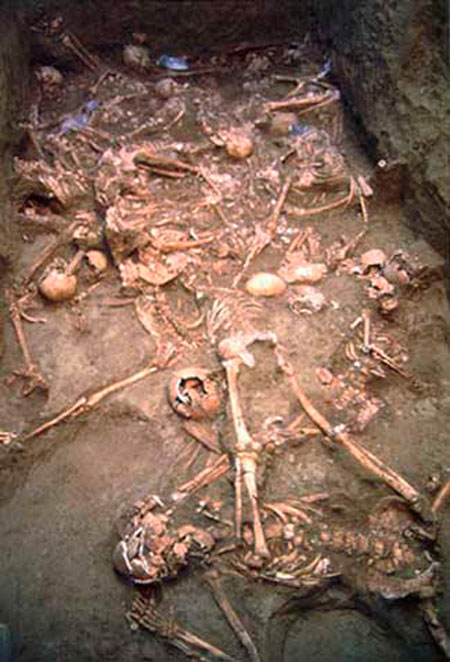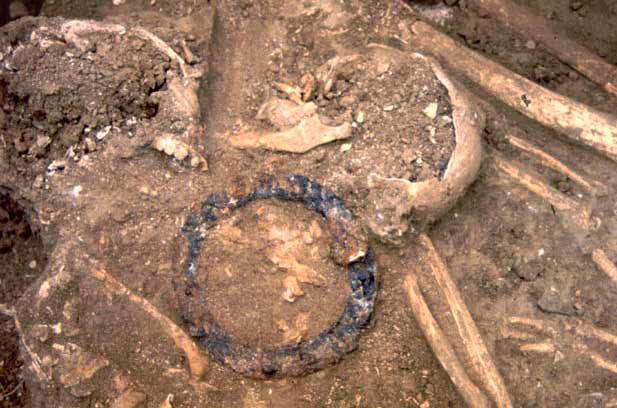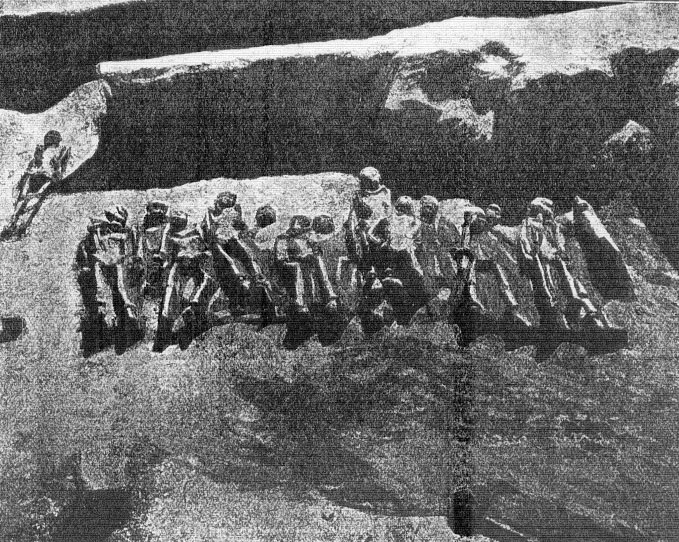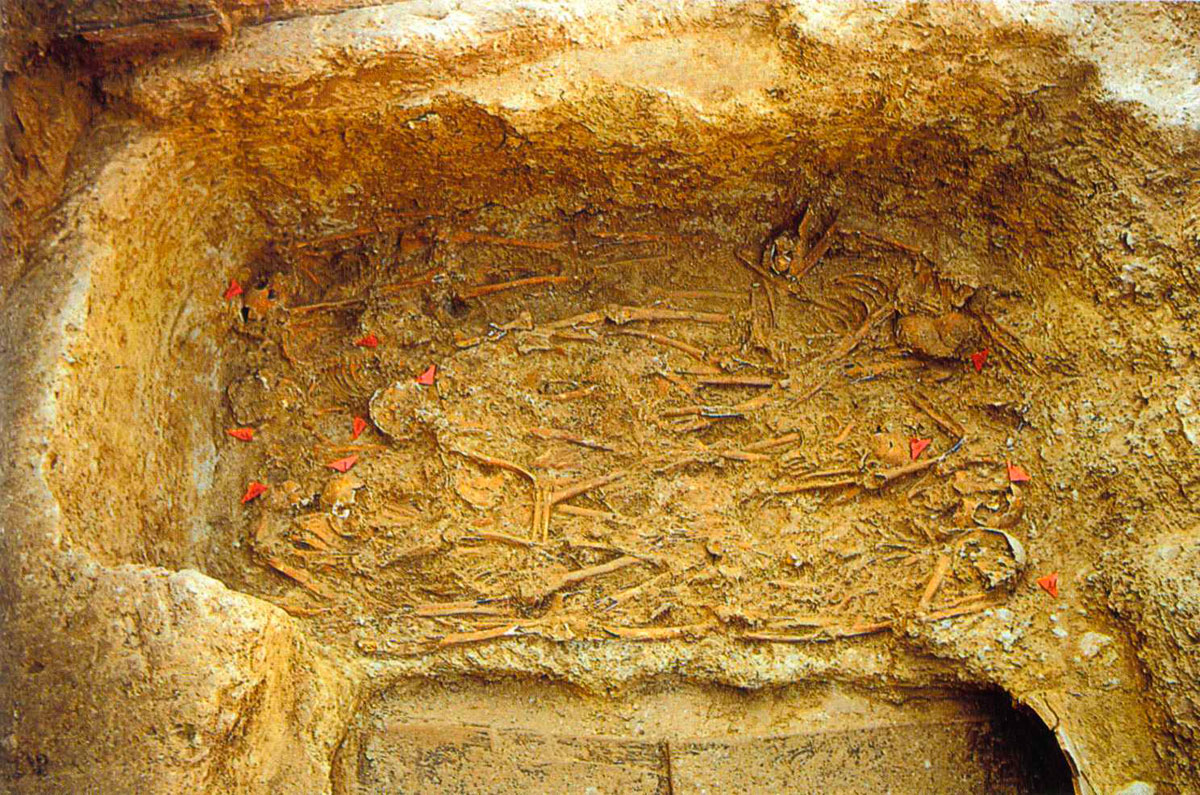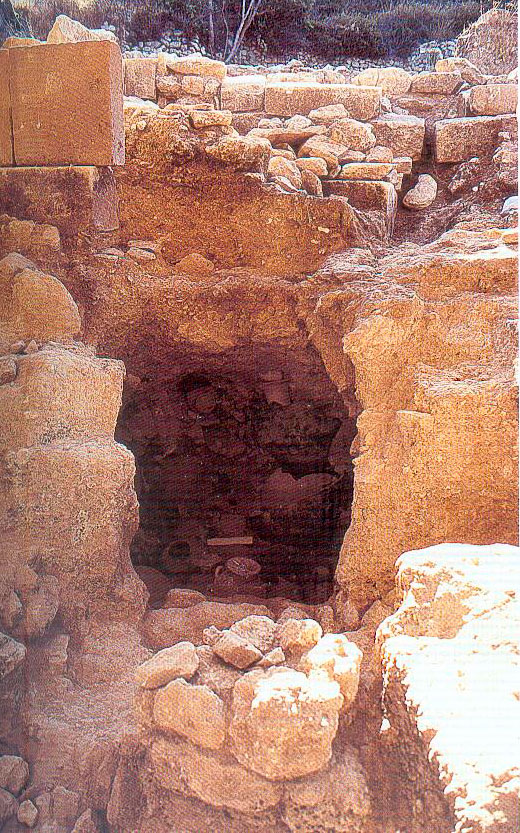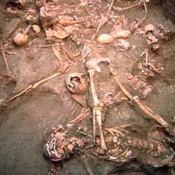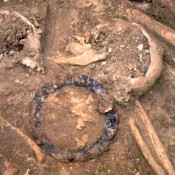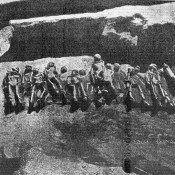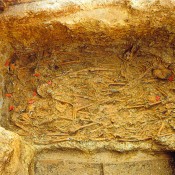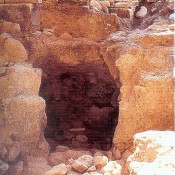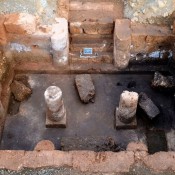Group burials in Greece are an unusual phenomenon in Antiquity. However, by occasionally finding archaeologically related peculiarities it becomes possible to locate a mass of evidence concerning individuals who lived or died in unusual social conditions. Moreover, treatment is often shown of these same deceased by those living members of a society which had included them for most or, at least, for the last part of their lives. There are different reasons for creating a group burial, as we shall discuss further on while examining particular examples. The most basic distinction is the accompaniment or not of the burial with the appropriate, statutory and accepted burial ceremony. It is therefore possible at a first level to separate the so called cases of “polyandria” from those cases of individuals buried hastily without great care. The former were group burials of warriors who fell in battle and to whom the state awarded special funerary honours, the latter were victims of epidemics, victims of raids, prisoners, slaves or convicts.
The fact however remains that public and group burials like those organized in 5th century Athens for the war dead, come in complete contrast to the private and rather introverted character of the ancient ceremonial practices and burial customs.
“Polyandria”, war victims
In the introductory chapter of his Funeral Oration, Thucydides (II.34) describes the ancestral law, namely the ceremony for the official burial of Athenian soldiers which took place once a year in the season that coincides with our autumn. During the ceremony the ashes and bones of the dead soldiers were transported in ten funerary coffers -one for each tribe in accordance with the system as defined by Cleisthenes-, while an eleventh empty coffer was carried in honour of the dead whose remains had not been able to be returned to their homeland.
The funerary coffers were transported to the Official Burial Site located outside the Dipylon Gate, in front of which a special square had been designed to host this annual ceremony, where Pericles’ famous Funeral Oration had also been delivered. We are, however, not able to specify from literary sources the proximity of the “polyandria” to this square (note 1). We know the existence of an inscribed marble stele that includes 169 names of the dead of the Sicilian campaign, while it is certain that similar monuments accompanied the annual ceremony with names etched in rows and separately for each tribe (note 2).
Recent surveys brought to light four new enclosures as well as a fifth the excavation of which is not possible due to the modern reconstruction work on Salamina road outside the Dipylon Gate (note 3). The location of these polyandria, the fact they are subterranean constructions, their relevance to funeral cartoning as well as their design and general construction indicate that they are funerary monuments. If we also assume that they are in fact polyandria from the Official Burial Site, then the skeletal remains found inside the enclosures do belong to Athenian warriors who died for their homeland. The offerings are numerous and of high quality and they can be dated from 430 to 420 BC, specifically during the time of the Archidameion War. According to the excavator, the fact that the bones were burned, whereas the pottery showed no traces of burning, perhaps echoes the old custom of cremating the dead on the battle field and the subsequent transportation of the bones in a funerary coffer to their homeland. A preliminary analysis of the skeletal remains showed that they were men of quite good physique. However the bones to be examined were randomly picked from only three polyandria, while research was further complicated by their having been exposed during cremation to temperatures exceeding 800 degrees Celsius. If these deceased were not victims of the Peloponnesian War but were instead victims of an epidemic that had struck Athens that same period, this would not become apparent from the osteological analysis (note 4).
In another case, a group burial was found undisturbed but without offerings inside a simple trench near Piraeus Rd. It contained 29 adults placed in a spread out arrangement with rudimentary care. The burial dates from 430-400 BC based on the minimum of pottery found there, a fact which lead the excavators to relate the find with “one of the events of the Peloponnesian War” (note 5). Without being able to exclude this more general approach because of the relatively great distance from the Official Burial Site where the dead warriors were buried and the grave’s quite poor appearance, it could be more logical to connect it with the plague epidemic that broke out that same period. Nevertheless, even if we do accept that it concerns the dead of some military campaign, for the reasons already mentioned, these dead do not appear to be Athenian citizens.
The warriors who did not survive the Battle of Marathon in 490 BC received special honours, since in order to praise their valour, their bones were not transferred to the Official Burial Site but were burned and buried in a mound that was created in situ. The excavation survey confirmed information by Herodotus (6.117) of the burial of 192 dead who were found in a layer of ashes together with the bones of sacrificial animals along with a multitude of pottery which had most probably been brought there by the families of the victims, pottery dating from the beginning of the 5th century. The burial mound, with a height of 12m and a diameter of 185m, had 10 marble funerary steles, one for each tribe of Athens, on which the names of the fallen appear in an exact analogy with the procedure undertaken by the Official Burial Site. It is worth mentioning information by Herodotus that next to the known mound was a second smaller one where slaves that fell in battle were buried. We know countless cases of slaves, possibly in a final effort to win their freedom, fighting for the city that had offered them hospitality and when failing to survive, receiving funerary honours equal to those entitled to citizens.
The more than 141 skeletons in funerary urns appear to have belonged to those in the district who had fallen heroically in battle. They were located in a closed archaeological ensemble in the so called grave A1K1 at the place Orthi Petra in Eleutherna. The interment of the dead had been done successively as the grave had been used uninterruptedly from the 9th to the mid 7th century. A study of the skeletal remains showed that they were quite healthy young adult males, tall and particularly robust, facts that indicate that they exercised regularly or possibly took part in military training. Because of the successive burials, the dead cannot be linked to a raid, epidemic, or some other isolated incident while the many weapons placed there as offerings lead us to suppose that they were warriors of the city who were honoured by being buried separately. The presence of four or five women comes as a surprise. According to the excavator, they must have died in childbirth and this was the reason for their special burial treatment (note 6).
We should stress here that, in relation to the polyandria, only four examples were examined from among the different types: the burial enclosure, the simple trench, the burial mound and the enchytrismoi (child burials in vessels) in a funerary monument. All the same, we know, both from historical sources and from scattered but plentiful examples, the existence, in almost all the city-states, of group graves for war victims with the island of Paros (note 7) being one of the earliest (Late Geometric period) and most representative examples.
Victims of epidemics and victims of raids
This category of group graves came about from the urgent need to clear the public or private spaces of great numbers of corpses so as to secure the health of the survivors. Consequently these were burials carried out under great pressure and in extreme haste while the dead received only basic funerary honours. We could say that, being in a state of panic, the relatives of the victims offered whatever they could as gifts to the deceased at that particular moment in time.
A typical example of a group burial of epidemic victims is a fairly recent find in the most southern boundaries of the Kerameikos cemetery. It is a simple trench with few and scattered offerings which was opened to accommodate superimposed burials of 85-150 dead, buried in an irregular and spread out manner. The great number of dead, the makeshift burial procedure, above all the dating of the funerary offerings from 430 to 426 BC, identify these dead as being the victims of the great plague that broke out in Athens in the years 430/29 and 427/6 BC Thucydides (ΙΙ.47.3-54) informs us of the panic that prevailed in Athens, while it is worth mentioning the better treatment received by the very young children that lost their lives in this plague, as proved by the location of a few jar burials of infants among the scattered bones (note 8).
We believe those found buried in the rock cut, arched, chamber tomb of the 2nd century BC in Derveni to be victims of raids, based on their relevance to historical events. Skeletal remains of at least 70 people were found there. It is interesting that the dead were carried to the tomb and laid in it on wooden stretchers as clearly indicated by the iron nails present in key positions round the bodies. The skeletons were found one on top of the other and the funerary offerings were minimal, there are, however, clear indications of the grave having been plundered. The explanation of this group burial being the result of a hasty internment of the victims of some raid is consistent with the fact that many bones show obvious signs of abuse such as distinct blows from sharp instruments, perhaps weapons or axes (note 9).
Cases of prisoners, slaves and convicts
This particular category of group burials is of great historical, archaeological and sociological interest, however, while it is fairly simple to include the finds in this general category that points at social marginalization, it is in the realm of pure conjecture to precisely identify those dead who are buried in a common grave without care and often in iron shackles. Occasionally several interpretations have been made such as identifying the shackled dead with slaves, with people suffering from epilepsy or mental diseases, with convicts, prisoners of war or Greek mercenaries that fought with the enemy armies and were buried in chains carrying the miasma of their country’s betrayal (note 10).
Well known examples of burials with shackles are the following: the no7437 cist grave, without funerary offerings, from the region of eastern Chalkidiki where the deceased had cuffs on his ankles joined together by iron chains (note 11), a burial at Vrendesium with a collar made up of two semicircular arcs, two cuffs with traces of bones of a foot from Chieti (note 12), eight individual burials with cuffs on their feet in the cemetery at Akanthos from the Hellenistic period, the group burial at Falero (note 14), the broken tibia with cuffs from the cemetery of Thebes in Fthiotida, a skeleton with cuffs in a gallery of the mines in Lavrion (note 15), the group burial in ancient Pydna (note 16), possibly some iron shackles in the Kaiadas from the Peloponnese (note 17), the cuffs from Lavrion inside which the bones of an ankle have been preserved, while examples of various metal shackles are known to us from north western Europe of the same period (note 18). During the first months of 2013 it became known that in the particularly interesting cemetery of Faleron, more skeletons with iron shackles had been located. No results from the survey however have been officially published till this article was written. Last, it is worth mentioning at this point that we know some very few examples of individuals that may not have worn shackles but who, from the posture of their spine, must obviously have been buried with their limbs tied. One such case is the beheaded man from the funerary pyre A in Eleutherna which has raised a multitude of questions as to whether or not this was a human sacrifice, a sacrificial slaying, a legitimate sentencing or an act of retaliation (note 19).
We can assume from the rarity of these finds that the shackles should not be linked to some established practice followed by society towards a particular category of human beings and that each case should be seen in the context of the particular customs of the region to which it belongs. It seems plausible that this case concerns slaves, since we know from Diodorus (ΧΧΧΙV/XXXV 2.27) that shackles were occasionally used for the punishment of insubordinate slaves as well as the habit of using shackles on slaves who worked in the mines(note 20). The possibility of these deceased having been mentally ill should be ruled out as unfounded, as there is no excuse for their having been buried in shackles even if they had worn them when alive, which is an equally unfounded hypothesis. It seems more probable they were convicts and this is confirmed by their specific historical and archaeological relevance in cases such as that of Faleron which will be discussed later. Their identification with prisoners of war is also convincing especially since we know from Herodotus (Ι.66 και V.77) and Pausanias (VIII.47.2) that enemy prisoners were put to work in shackles to the end of their lives both by the citizens of Tegea and by the Athenians. Last, regarding Greek mercenaries who had served in foreign armies, Arrian (Arrian,The Anabasis /Expedition of Alexander Ι.16) informs us that Alexander forced Greek soldiers who had fought on the side of the Persians to return to Macedonia where they would spend the rest of their lives labouring in shackles (note 21).
Although it is apparent that we cannot clearly define these people’s social status, nevertheless, the burial chosen for them in those same shackles they wore in life, is indicative of their treatment by the society they were directly or indirectly in contact with (note 22). Not only were they obliged, as units, to be bound to their society both ideologically and practically, but they were held in contempt up to their last moments by maintaining their shackles even after death. Consequently, despite some individual distinctions, it seems that all of them, without exception, were social outcasts, rejected by their fellow men.
A typical example of this kind is the group burial of at least 120 people in the northern cemetery of ancient Pydna dating from the 4th c BC ( note 23). The depositing of the skeletons was done in four consecutive phases without this incurring the simultaneous placement of all the remains of each phase, a fact confirmed by its archaeological context. The burial was poor and hasty, although, apparently, there was a rough grave marker, perhaps a funerary chapel, in the outer, most northern section of the trench (where the entrance for accessing it was probably to be found). The skeletons had basically been carelessly thrown in without funerary offerings except for an iron strigil, a surprising object being closely associated with athletics, which, in turn, is an activity linked to economic prosperity. In this case as well, special attention is worth paying to the iron shackles worn by four of the deceased, which included a collar, a single hand cuff and a total of three ankle shackles ,all worn by individuals belonging to different phases of depositing. Osteological analysis showed that this group burial included individuals of both sexes and of all ages, with severe muscular and skeletal lesions revealing painful, repetitive, hard manual work as well as marked signs of stress caused by malnutrition, a fact clearly pointing to the deceased’s poverty. None of these cases show signs of violent death or death caused by an epidemic. Therefore, it is particularly appropriate to identify as slaves the dead wearing iron shackles and consequently all the rest of those buried people. Given that the burial, as a whole, proves that these dead had always been poor or were so as a result of their likely captivity, it is difficult to assume that the people buried there belonged to different social groups.
As we are told by Diodorus the Sicilian (5.38.1) those slaves working in the mines and mainly the ones wearing shackles, were forced to endure unbearable living conditions. It seems, however, that among the slaves there were also privileged groups of so called “urban” slaves who enjoyed much better treatment. By the last years of Classical antiquity, the phenomenon of insubordination and of small insurrections almost disappeared, with the habit spreading of the master of a household granting his slaves their freedom in his will. Nevertheless, it seems that these circumstances applied mainly to house slaves and not those working in mines or in agriculture. In these cases, despite both restrictive and safety measures that included iron shackles and the incentives provided, slaves occasionally revolted (note 24). A depiction of the habit of slaves being transported in chains can be located in the lower frieze of the funerary stele in Amphipolis, where a man named Aulus Capreilius Timotheus is mentioned, whose name is accompanied by the description of slave trader (note 25).
It seems clearer to determine the graves of convicts. From what we know from literary sources, there were three lawful ways of executing convicts in Athens: their drinking of hemlock, their being thrown into a ravine and their death by the method of apotympanismus (note 26). There was an equal number of methods for treating their remains after death: the dead were either returned to their relatives to be given a proper burial, or they were thrown into a ravine when their sentence included the denial of funerary honours, or last they were allowed a proper burial but not in Attica (note 27), a practice that was used in the case of sacrilege or treason. A characteristic case is that of Socrates who having been condemned to death by drinking hemlock was returned to his relatives so that his burial could be accompanied by the appropriate ceremony (note 28).
It seems that in early times the convicts were thrown into the ravine when alive, but later the death sentences were carried out in prison and then the corpses were taken to the ravine, until finally their burial was allowed outside the boundaries of the territory of Attica, except for cases where the remains were returned to the relatives. According to some researchers the use of the ravine was discontinued for health reasons. As far as we know, the Athenian ravine was located on the west side of the Hill of the Nymphs. The fact has been handed down to us that the ravine filled up after a Phrygian convict was thrown into it (note 29).
According to historical sources and in direct correspondence to what was going on in Athens, convicts, prisoners of war and those considered as traitors came to a tragic end in the Kaiadas gorge in Sparta. Results from the study of the skeletal remains showed that the three metre deep backfilling of the Kaiadas gorge was made up mainly of human bones. Their state indicated that whole bodies were placed or thrown into the gorge and that they were not part of a secondary process of digging up and storage of buried bones (anakomide). It is also of great interest to note the presence of either entire or sections of skeletons in recesses of the gorge walls and at a considerable distance from today’s ground level. This fact is possible evidence of the effort made either by the condemned surviving the fall to climb up to the entrance at the top or by those having been flung in to stop their fall and hold on. The majority of the bones belong to men between 20 and 30 years old. There is a scarcity of women and individuals from different age groups. The very few existing women’s remains are possibly related to the last Messenian uprising between 464-459 BC where, according to historical sources, women are presumed to have participated. A fragment of a skull was located among the many skeletal remains with a bronze projectile’s edge nailed in it, while according to the locals, there were metal “hoops or bands” [«χαλκάδες»], in the gorge, information that, however, was never confirmed by archaeologists.
A particularly interesting discovery in Faleron, Attica, is that of a grave of 17 or 18 people who had been executed in the apotympanismos method in the 5th century BC and buried in a cemetery of the 7th century BC which was no longer in use. In general the procedure seems to have been the following: The convicted man was tied on wide wooden planks called “tympana” which were fastened vertically to the ground. Next, he was tied to a total of five iron rings with an opening in their lower section (shaped either like an Ω, a double fish hook or a chain link), one round his neck, one on each wrist and on either ankle. He remained hanging in this manner till he was dead without being given either food or water. This particular torture lasted perhaps for over ten days during which the convicted men suffered from the pressure of their own bodies against the iron shackles. This practice is described in Aristophanes’ play “Thesmophoriazousae” when Mnesilochos’ punishment is mentioned.
It seems that in order for their punishment to set an example the so called “ironshackled men” [«σιδηρόδετοι»] of Faleron had been put to death in a spot visible to all, the starting point/beginning of the road which led from Athens to Faleron, the city’s harbour at that time. On the other hand, there is almost certainly no proof for the view held that the burial of these dead, rather than their being thrown in the gorge, was an act of leniency (note 30). They were found in an enclosure 4,80m wide and 2,50m long, lying one next to the other. One of them is missing most of his legs, he is decapitated and his right arm severely wounded as if he was trying to free himself of his bonds, while it is obvious from the skeletons’ positions that they were all tied to the same tympanon.
Earlier researchers hesitated to admit the fact that this humiliating death of the Faleron convicts was a public spectacle, because this was opposed to the aesthetics as well as the ethos of Democratic Athens, as understood by current research. They also unanimously rejected as completely barbaric the possibility of some of the “ironshackled men” having been buried alive or left to the mercy of the birds of prey (this would explain however the amputations of some of the skeletons), while they believed that those not already dead by torture were killed with arrows, as indicated by an arrowhead in one of the skeleton’s chests.
Many explanations were given as to the identity of the polyandrion of Falyron with the following being the most interesting: They were pirates, rebel slaves from the mines of Lavrion, victims of the Thirty Tyrants, the prisoners of some war, supporters of Kylon, victims of Hippias, shipwrecked Persians, people of Aegina, Mytilene, or people who had insulted the gods or the holy rituals. Pelekides, in particular, examining the horror of this manner of death and the historical testimonies of his time, identifies the dead with the Ermokopides,an interpretation that seems very attractive and for the most part documented (note 31). For whatever reason, this extremely interesting find, illustrating a darker moment in the history of democratic Athens, is unique and should be handled as such in regards to how interpretative approaches are formulated.
Conclusions
We can conclude by saying that in classical antiquity there were three basic reasons for creating a group burial:
-The endeavour to pay special homage to the war victims, to praise the valour they showed in battle, to promote them as followers and prototypes of the philosophy of being Fair and Good (kalos kagathos), but also to promote the prosperity and concord of the city-state through the ceremonies that accompanied the burial. It is, however, legitimate to bear in mind that the prosperous generals and politicians killed in battle were honoured and buried in private monuments which, depending on the period, could be particularly luxurious.
– The endeavour by the authorities to purge both the streets and the houses of each city after the unannounced tragic events such as epidemics and raids which left many dead in their wake, for whom, sometimes, no one could take responsibility and who with their gradual decomposition were a grave danger to public health.
– The endeavour by society to marginalize or cast out individuals belonging to groups which were at a real disadvantage compared to the rest of society. The rejection these individuals experienced during their lives, whether excusable or not, followed them to the grave. They were deprived of even the most rudimentary honours which caused the greatest misery, according to both literary sources and the ideology of the time.
Here we should point out that proper attention has not been given to group burials from the historical times despite their being particularly interesting due to complex questions arising from their historic and archaeological relevance. So far, they have never been published as a single whole, examined comparatively. Moreover, in the field of classical archaeology, the osteological studies that help definitively in identifying people buried in this manner, as in the cases from Athens, Pydna and Eleutherna, are still considered as extra and unnecessary work, perhaps because there is so much other evidence, while often the interesting results that come from palaiodemography and palaiopathology are not used. It therefore remains a duty for future research to go ahead with a more thorough study which will allow the particular social groups represented in these graves of a specific form to be determined in an absolutely precise manner.
Katerina Logothetis
Archaeologist
